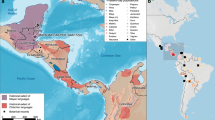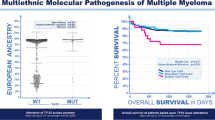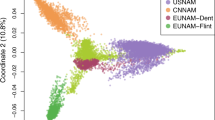Abstract
The Mayan homeland within Mesoamerica spans five countries: Belize, El Salvador, Guatemala, Honduras and Mexico. There are indications that the people we call the Maya migrated from the north to the highlands of Guatemala as early as 4000 B.C. Their existence was village-based and agricultural. The culture of these Preclassic Mayans owes much to the earlier Olmec civilization, which flourished in the southern portion of North America. In this study, four different Mayan groups were examined to assess their genetic variability. Ten polymorphic Alu insertion (PAI) loci were employed to ascertain the genetic affinities among these Mayan groups. North American, African, European and Asian populations were also examined as reference populations. Our results suggest that the Mayan groups examined in this study are not genetically homogeneous.
Similar content being viewed by others
Log in or create a free account to read this content
Gain free access to this article, as well as selected content from this journal and more on nature.com
or
References
Antunez De Mayolo A, Antunez De Mayolo G, Thomas E, Reategui EP, Brown M, Herrera RJ (1999) Worldwide distribution of a polymorphic Alu insertion in the progesterone gene. In: Papiha SS, Deka R, Chakraborty R (eds) Genomic diversity: applications in human population genetics. Kluwer Academic/Plenum Publishers, New York, pp 213–222
Antunez De Mayolo G, Antunez De Mayolo P, Antunez De Mayolo A, Papiha Ss, Hammer MF, Yunis E, Yunis J, Damodaran C, York D, Martinez De Pancorbo M, Stoneking M, Caeiro JL, Puzyver VP, Herrera RJ (2002) Phylogenetics of worldwide human populations as determined by polymorphic Alu insertions. Electrophoresis 23:3346–3356
Arnaiz-Villena A, Vargas-Alarcón G, Granados J, Gómez-Casado E, Longas J, Gonzales-Hevilla M, Zuñiga J, Salgado N, Hernández-Pacheco G, Guillen J, Martinez-Laso J (2000) HLA genes in Mexican Mazatecans, the peopling of the Americas and the uniqueness of Amerindians. Tissue Antigens 56:405–416
Batzer MA, Deininger PL (1991) A human-specific subfamily of Alu sequences. Genomics 9:481–487
Batzer MA, Stoneking M, Alegria-Hartman M, Bazan H, Kass DH, Shaikh TH, Novick GE, Ioannou PA, Scheer WD, Herrera RJ, Deininger PL (1994) African origin of human-specific polymorphic Alu insertions. Proc Natl Acad Sci USA 91:12288–12292
Batzer MA, Arcot SS, Phinney JW, Alegria-Hartman M, Kass DH, Milligan SM, Kimpton C, Gill P, Hochmeister M, Ioannou PA, Herrera RJ, Boudreau DA, Scheer WD, keats BJB, Deininger PL, Stoneking M (1996) Genetic variation of recent Alu insertions in human populations. J Mol Evol 42:22–29
Bianchi NO, Bailliet G, Bravi C, Carnese RF, Rothhammer F, Martinez-Marignac VL, Pena SDJ (1997) Origin of Amerindian Y-chromosomes as inferred by the analysis of six polymorphic markers. Am J Phys Anthropol 102:79–89
Bianchi NO, Catanesi CI, Bailliet G, Martinez-Marignac VL, Bravi CM, Vidal-Rioja LB, Herrera RJ, López-Camelo JS (1998) Characterization of ancestral and derived Y-chromosome haplotypes of New World populations. Am J Hum Genet 63:1862–1871
Black FL (1991) Reasons for failure of genetic classifications of South Amerindian populations. Hum Biol 63:763–774
Black W (1996) BIOSYS-2: a computer program for the analysis of allelic variation in genetics. Department of Microbiology, Colorado State University. Available at ftp://www.lamar.colostate.edu/pub/wcb4/
Bonatto SL, Salzano FM (1997) A single and early migration for the peopling of the Americas supported by mitochondrial DNA sequence data. Proc Natl Acad Sci USA 94:1866–1871
Bortolini MC, Baptista C, Callegari-Jacques SM, Weimer TA, Salzano FM (1998) Diversity in protein, nuclear DNA and mtDNA in South Amerinds. Agreement or discrepancy. Ann Hum Genet 62:133–145
Carroll ML, Roy-Engel AM, Nguyen SV, Salem AH, Vogel E, Bethaney V, Myers J, Ahmad Z, Nguyen L, Sammarco M, Watkins WS, Henke J, Makalowski W, Jorde LB, Deininger PL, Batzer M (2001) Large-scale analysis of the Alu Ya5 and Ya8 subfamilies and their contribution to human genomic diversity. J Mol Biol 311:17–40
Coe MD (1992) The history of the Maya decipherment in breaking the Maya code. Thames & Hudson, Inc. Publishers, London, New York
Crawford MH (1998) The origins of Native Americans. Evidence from anthropological genetics. Cambridge University Press, Cambridge
Donaldson CJ, Crapanzano JP, Watson JC, Levine EA, Batzer MA (2002) PROGINS Alu insertion and human genomic diversity. Mutat Res 501:137–141
Excoffier L, Smouse P, Quattro J (1992) Analysis of molecular variance inferred from metric distances among DNA haplotypes: application to human mitochondrial DNA data. Genetics 131:479–491
Fagundes NJR, Bonatto SL, Callegari-Jacques SM, Salzano FM (2002) Genetic, geographic, and linguistic variation among South American Indians: possible sex influence. Am J Phys Anthropol 117:68–78
Felsentein J (1993) PHYLIP (Phylogeny Inference Package), version b 3.5. Department of Genetics, University of Washington, Seattle
Greenberg JH (1987) Language in the Americas. Stanford University Press, Stanford
Harpending HC, Ward RH (1982) Chemical systematic and human population. In: Nitecki M (ed) Biochemical aspects of evolutionary biology. University of Chicago Press, Chicago, pp 213–252
Hillis DM (1999) SINEs of the perfect character. Proc Natl Acad Sci USA 96:9979–9981
Karathanasis SK (1985) Apolipoprotein multigene family: tandem organization of apolipoprotein AI, CIII, and AIV genes. Proc Natl Acad Sci USA 82:6374–6378
Li CC (1976) First course in population genetics. Boxwood Press, Pacific Groove
Martinez L, Reategui EP, Fonseca L, Sierra-Montes JM, Terreros MC, Pereira-Simon S, Herrera RJ (2005) Superimposing Polymorphism: the case of a point mutation within a polymorphic Alu insertion. Hum Hered 59:109–117
Mateus-Pereira LH, Socorro A, Fernandez I, Masleh M, Vidal D, Bianchi NO, Bonatto SL, Salzano FM, Herrera RJ (2005) Phylogenetic information in polymorphic L1 and Alu insertions from East Asians and Native American populations. Am J Phys Anthropol 128:171–184
Milewicz DM, Byers PH, Reveille J, Hughes J, Duvic M (1996) A dimorphic Alu Sb-like insertion in COL3A1 is ethnic-specific. J Mol Evol 42:117–123
Nei M (1987) Molecular evolutionary genetics. Columbia University Press, New York
Novick GE, Novick CC, Yunis E et al (1995) Polymorphic human-specific Alu insertions as markers for human identification. Electrophoresis 16:1596–1601
Novick GE, Novick CC, Yunis J, Yunis E, Antunez De Mayolo P, Scheer WD, Deininger P, Stoneking M, York D, Batzer MA, Herrera RJ (1998) Polymorphic Alu insertions and the Asian origin of Native American populations. Hum Biol 70:23–39
Ota T (1993) DISPAN: genetic distance and phylogenetic analysis. Institute of Molecular Evolutionary Genetics, Pennsylvania State University. Available at ftp://www.bio.indiana.edu/molbio/ibmpc/
Roff DA, Bentzen P (1989) The statistical analysis of mitochondrial DNA polymorphism: χ2 and the problem of small samples. Mol Biol Evol 6:539–545
Rohlf FJ (1998) NTSYSpc numerical taxonomy and multivariate analysis system, version 2.02i. Applied Biostatistics Inc., Department of Ecology and Evolution, State University of New York
Rowen L, Koop B, Hood L (1996) The complete 685-Kilobase DNA sequence of the human βT cell receptor locus. Sciences 272:1755–1765
Roy AM, Caroll ML, Kass DH, Nguyen SV, Salem A, Batzer MA, Deininger P (1999) Recently integrated human Alu repeats: finding needles in the haystack. Gentetica 107:149–161
Salzano FM (2002) Molecular variability in Amerindians: widespread but uneven information. An Acad Bras Ciênc 74:223–263
Salzano FM, Callegari-Jacques SM (1988) South American Indians: a case study in evolution. Clarendon Press, Oxford
Santos FR, Delfín LR, Pena SDJ, Moore J, Weiss KM (1996) North and South Amerindians may have the same major founder Y chromosome haplotype. Am J Hum Genet 58:1369–1370
Schneider S, Roessli D, Excoffier L (2000) Arlequin ver. 2.000: a software for population genetics data analysis. Genetics and Biometry Laboratory, University of Geneva, Switzerland
Silva WA, Bonatto SL, Holanda AJ, Ribeiro-dos-Santos AK, Paixão BM, Goldman GH, Abe-Sandes K, Rodriguez-Delfin L, Barbosa M, Paçó-Larson ML, Petzl-Erler ML, Valente V, Santos SEB and Zago MA (2002) Mitochondrial genome diversity of Native Americans supports a single early entry of founder populations into America. Am J Hum Genet 71:187–192
Sneath PHA, Sokal RR (1973) Numerical taxonomy: the principles and practice of numerical classification. Freeman, San Francisco
Stoneking M, Fontius J, Clifford S, Soodyall H, Arcot SS, Saha N, Jenkins T, Tahir MA, Deininger PL, Batzer MA (1997) Alu insertion polymorphisms and human evolution: evidence for a larger population size in Africa. Genome Res 7:1061–1071
Terreros MC, Martinez L, Herrera RJ (2005) Polymorphic Alu insertions and genetic diversity among African populations. Hum Biol 77:675–704
Tiret L, Riget B, Visvikis S, Breda C, Corvol P, Cambien F, Soubrier F (1992) Evidence from combined segregation and linkage analysis, that a variant of the angiotensin I-converting enzyme (ACE) gene controls plasma ACE levels. Am J Hum Genet 51:197–205
Watkins WS, Ricker CE, Bamshad MJ, Carroll ML, Nguyen SV, Batzer MA, Harpending HC, Rogers AR, Jorde LB (2001) Patterns of ancestral human diversity: an analysis of Alu-insertion and restriction-site polymorphisms. Am J Hum Genet 68:738–752
York DS, Blum VM, Low JA, Rowold D, Puzyrev V, Saliukov V, Odinokova O, Herrera RJ (1999) Phylogenetic signals from point mutations and polymorphic Alu insertions. Genetica 107:163–170
Author information
Authors and Affiliations
Corresponding author
Rights and permissions
About this article
Cite this article
Herrera, R.J., Rojas, D.P. & Terreros, M.C. Polymorphic Alu insertions among Mayan populations. J Hum Genet 52, 129–142 (2007). https://doi.org/10.1007/s10038-006-0089-y
Received:
Accepted:
Published:
Issue date:
DOI: https://doi.org/10.1007/s10038-006-0089-y
Keywords
This article is cited by
-
Frequency of Alu insertions within the ACE and PR loci in Northwestern Mexicans
BMC Research Notes (2017)
-
Genomic insights on the ethno-history of the Maya and the ‘Ladinos’ from Guatemala
BMC Genomics (2015)
-
Frequency of thiopurine S-methyltransferase mutant alleles in indigenous and admixed Guatemalan patients with acute lymphoblastic leukemia
Medical Oncology (2013)



